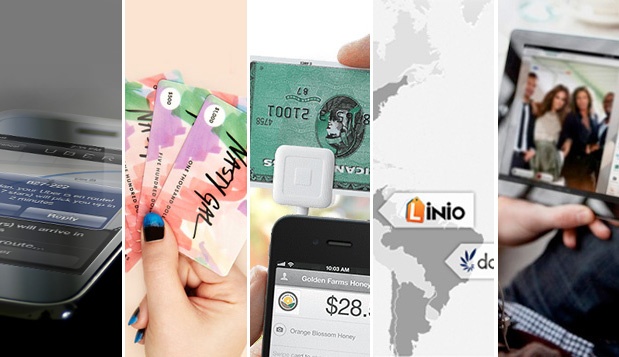David Klein | Mashable
Some companies seem to have an innate sense of just what it takes to attract a market. Or, perhaps it only appears that way. For most companies, it’s more likely that they learn through trial and error, research, and testing until they get it right.
The following five companies have each developed inbound marketing strategies that truly work. Here’s what those look like.

1. Salesforce: Leverages Content to Market the Cloud
According to Kieran Flanagan, inbound marketing manager for Salesforce.com, “The new B2B purchase journey is search-initiated, social powered, and buyer-controlled.” In fact, his take on the 80/20 rule is that for social success, it’s more like 90/10. That means 90% of your content marketing should be about customers and only 10% about your products. As the brains behind the Salesforce strategy, Flanagan’s job is “to produce transformational marketing that attracts visitors naturally through mediums like search engines, the blogosphere, and social media.”
The Salesforce strategy has been to generate leads by building — and effectively promoting, through multiple channels — a “content-rich micro-site” valued by the target market. Flanagan decided to use four different content types: Created (original content created from scratch), curated (round-up style content), collaborative (content contributed by relevant thought leaders), and legacy (re-purposed and repackaged content).
The result? During the first month after implementation, the company saw the following gains: January traffic was up 80% when compared to January of the previous year. Social media traffic was up 2,500%, there were 6,500 newsletter signups, and 10,000 ebook downloads. This effectively translated to 10,000 leads.
2. Cisco: Focuses on the Cloud and Mobile
After a rough couple of years, Cisco is managing a turnaround that, according to Shaw Woo, senior technology analyst at Sterne Agee, is under-appreciated.
In an August 16th CNBC interview, Woo stated that the network equipment vendor’s turnaround was accomplished by “taking advantage of the cloud [and] taking advantage of mobile.” Cisco’s CEO, John Chambers, is said to have set a precedent by changing the company’s strategy. He lowered the cost structure, making the company more competitive. He also made it more “shareholder-friendly” by committing to return at least half of the company’s profits to shareholders.
In that same spirit, the company is publishing a collection of My Networked Life video documentaries, a series it bills as “true stories from a connected world.” The videos, published on the Cisco website and publicized through its social media pages, tell the “personal” and “powerful” stories of “how young professionals, entrepreneurs, artists, and students are using connected technology to achieve goals and realize dreams.” This is just one more way the company is reinforcing its “human” image.
The company also made a calculated switch from conventional advertising to brand journalism, which is helping consumers envision the potential improvements Cisco’s products and services can bring to their lives.
3. Dell: Takes a Multi-Layered Approach
Founded in 1984, Dell has become a force to be reckoned with in the computer sales market, and it has done so, in large part, through savvy inbound marketing practices. While its marketing strategy has always been multilayered, the computer giant has always encouraged customer feedback and participation in its product development. Today it is not only announcing new products on its Facebook page and engaging fans by asking questions and encouraging them to click “like” on its posts, it’s also addressing their need for knowledge through a blog, newsletter, and a glossy magazine.
The company is also making the most of the video medium by featuring a growing collection of videos on its Facebook page, tweeting about them on Twitter, and promoting them on other social media.
Dell is also leveraging mobile technology to attract greater response to its marketing e-mails. By adding the mobile element to its standard desktop marketing e-mail and making significant changes to its mobile e-mail version, Dell managed to garner an impressive five-fold increase in downloads of the app the day the e-mails went out.
4. GE: Focuses on Experts, Ingenuity, and Innovation
When GE reinvented its marketing in 2011, much of its effort focused on several disciplines that today would be considered critical components of inbound marketing. These included strategy and innovation, branding and communications, value creation, and pricing.
One key strategy the company embraced in its new marketing mix was the practice of highlighting its experts and the critical role they play in bringing GE products to market. Currently, the company is reinforcing that focus by featuring links to its experts’ Twitter profiles on the GE homepage under the heading “Meet the People Who Make GE Work.”
For the past year, the company has also sponsored an online magazine called Txchnologist, which it describes on its About Us page as offering “an optimistic, but not utopian, take on the future and humanity’s ability to tackle the great challenges of our era through industry, technology and ingenuity.”
The company also posts periodic videotaped interviews with its experts, via the Txchnologist YouTube channel. Again, this is meant to reinforce the expert element, although its videos don’t appear to be posted frequently enough to play as significant a role in its inbound marketing strategy as Dell’s do.
5. Starbucks: Works on Connecting with Customers
Starbucks is all about “connecting,” whether that’s chatting with a customer over a steaming latte, interacting with fans on the company’s Facebook page, or posting fascinating photos on Instagram. The well-known coffee chain has effectively created an emotional connection with its customers. In countries like the U.K. and Ireland this connection made the company’s recent campaign to have its baristas start connecting with customers on a first-name basis that much smoother. The company launched the campaign with a promotion promising customers a free latte to come in and introduce themselves.
Starbucks, a pioneer in mobile advertising, is clearly savvy about connecting in more ways than just in person and online. Named Mobile Marketer of the year in 2010, the company launched an app the following year that accepted mobile payments and, less than a year later, saw an impressive 26 million mobile transactions, with mobile devices accounting for $110 million worth of funds reloaded to customers’ Starbucks cards.
Starbucks is also making the most of the features and functions of its social networks to grow its fan base and maximize likes, shares, and re-tweets. All these digital word-of-mouth marketing opportunities help Starbucks get found by a growing audience that, on Twitter, currently exceeds 2.8 million followers and, on Facebook, has registered more than 31.5 million likes to the company’s business page.
And, speaking of social, the company’s strong focus on social responsibility hasn’t hurt its popularity either. In short, the gentle corporate coffee giant has become the company everybody loves to love.












